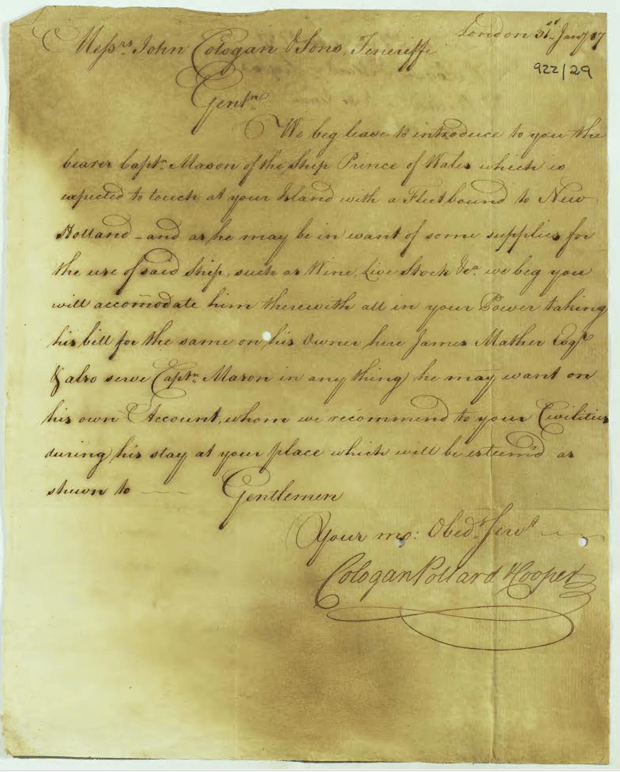A Letter of Credit for the First Fleet
The merchant ships which carried out convicts and provisions as part of Australia’s First Fleet were obliged to purchase food and drink for the officers and crew when they touched at foreign ports. In some cases, they might have paid in cash, but they also carried ‘letters of credit’ enabling them to draw on trading houses in London.
Gary L. Sturgess
6/27/20242 min read
Commercial papers relating to the First Fleet ships are virtually non-existent – charter parties, crew contracts, insurance notes, bills of lading, account books, inventories of the ships’ furniture and the stores and provisions on board, Trinity House receipts, cockets and bills of health, arrival papers and quarantine clearances, letters of instruction from the owners and the contractor, receipts for goods bought in foreign ports, letters of credit.
The legal, financial and managerial foundations of the First Fleet might not be particularly interesting to genealogists and family historians, but they are vital for researchers seeking to understand how the Botany Bay system worked.
It is possible to make do by accessing the documentation of later ships. We have a list of the ship’s papers that were on board the Lady Shore, when she was captured by the soldiers on board in 1797 and taken into Monte Video on the South American coast. And a largely complete set of documents exists for the Competitor, a transport which sailed out in 1823.[1]
But almost nothing survives for the First Fleet. For example, no copies of the Navy Board’s contract with William Richards have survived, leading some historians to conclude, wrongly, that there was no such document. A contract between Richards and one of the ship owners has survived – it was preserved in government archives because of a legal dispute over who was responsible for the decision to scuttle her in the Macassar Strait on the homeward voyage.
The only other commercial documents known to exist are two letters of credit used at Tenerife for the purchase of fresh provisions and wine. They were both issued by the London partnership of Cologan, Pollard & Cooper, addressed to the related firm of John Cologan & Sons at Tenerife, in favour of John Mason, the captain of the Prince of Wales, and John Watts, a naval lieutenant on leave who had sailed out on the Lady Penrhyn as a supernumerary.
Mason’s letter refers to wine and livestock, but we don’t know what he purchased from Cologan & Sons on the 4th of June, the day after the fleet arrived. Watts bought two hogsheads of wine and one hundred eggs, on an unknown date. These documents are held by descendants of the Cologan family in Tenerife – it is likely that they have other such documents relating to the First Fleet, but they are not currently available.
The journal of the Prince of Wales makes no mention of provisions taken on board at Tenerife for the crew, although this is not unexpected since it is a quick copy made for the government’s records, and the entries are brief. John Watts kept a journal, but thus far, we only have a small proportion of it.
Cologan, Pollard & Cooper also put a proposal to government for Cologan & Sons to supply the marines with wine when the fleet touched at Tenerife. The offer was refused because their orders made no mention of wine or spirits being included with their rations.
They are not much, but they throw light, just a little, into the otherwise dark interior of the master’s cabin.
____________
[1] Archivo Histórico Nacional, Madrid, Estado, 3520-1, Reel 3, p.161ff; ‘Charter parties, instructions, permits, store lists, licences, certificates, surgeon's papers etc for the convict transport Competitor, bound for New South Wales: Deptford, Woolwich, London’, The UK National Archives, (TNA) C109/195.


31 January 1787 – Letter from Cologan, Pollard & Cooper, London, to Messrs John Cologan & Sons, Tenerife (original in possession of the Cologan family in Tenerife).
Contact us
Connect with us
Botany Baymen acknowledges the traditional custodians of country throughout Australia and respects their connection to land, water and community.
© Botany Baymen 2024. All rights reserved.
You may download, display, print and reproduce this content for your personal or non-commercial use but only in an unaltered form and with the copyright acknowledged.

